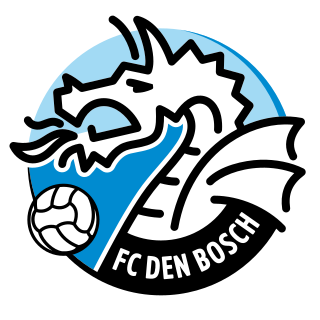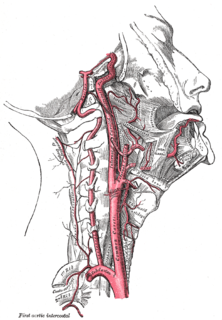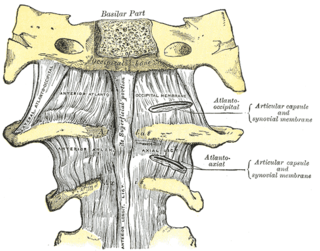
FC Den Bosch is a football club from 's-Hertogenbosch, Netherlands.

The Hague is a city on the western coast of the Netherlands on the North Sea and the capital of the province of South Holland. It is also the seat of government of the Netherlands and hosts the International Court of Justice, one of the most important courts in the world.

In anatomy, the atlas (C1) is the most superior (first) cervical vertebra of the spine and is located in the neck. It is named for Atlas of Greek mythology because, just as Atlas supported the globe, it supports the entire head.

Alles Door Oefening Den Haag, commonly known by the abbreviated name ADO Den Haag, is a Dutch association football club from the city of The Hague. The club was for a time known as FC Den Haag, with ADO representing the amateur branch of the club. Despite being from one of the traditional three large Dutch cities, it has not been able to match Ajax, Feyenoord or PSV in terms of success in the Eredivisie or in European competition. There is nonetheless a big rivalry with Ajax and Feyenoord. The words Alles Door Oefening translate into Everything Through Practice in Dutch.

In anatomy, the second cervical vertebra (C2) of the spine is named the axis or epistropheus.

In tetrapods, cervical vertebrae are the vertebrae of the neck, immediately below the skull. Truncal vertebrae lie caudal of cervical vertebrae. In sauropsid species, the cervical vertebrae bear cervical ribs. In lizards and saurischian dinosaurs, the cervical ribs are large; in birds, they are small and completely fused to the vertebrae. The vertebral transverse processes of mammals are homologous to the cervical ribs of other amniotes. Most mammals have seven cervical vertebrae, with the only three known exceptions being the manatee with six, the two-toed sloth with five or six, and the three-toed sloth with nine.

Morquio syndrome, also known as Mucopolysaccharidosis Type IV , is a rare metabolic disorder in which the body cannot process certain types of sugar molecules called glycosaminoglycans. In Morquio syndrome, the specific GAG which builds up in the body is called keratan sulfate. This birth defect, which is autosomal recessive, is a type of lysosomal storage disorder. The buildup of GAGs in different parts of the body causes symptoms in many different organ systems. In the US, the incidence rate for Morquio is estimated at between 1 in 200,000 and 1 in 300,000 live births.

In anatomy, the alar ligaments are ligaments which connect the dens to tubercles on the medial side of the occipital condyle.

Phyllodytes is a genus of frogs in the family Hylidae. It is endemic to eastern Brazil.

The ascending pharyngeal artery is an artery in the neck that supplies the pharynx, developing from the proximal part of the embryonic second aortic arch.

The atlantoaxial joint is a joint in the upper part of the neck between the first and second cervical vertebrae; the atlas and axis. It is a pivot joint.

Hangman's fracture is the colloquial name given to a fracture of both pedicles, or pars interarticulares, of the axis vertebra (C2).

The ligament of apex dentis is a ligament that spans between the second cervical vertebra in the neck and the skull. It lies as a fibrous cord in the triangular interval between the alar ligaments, which extends from the tip of the odontoid process on the axis to the anterior margin of the foramen magnum, being intimately blended with the deep portion of the anterior atlantooccipital membrane and superior crus of the transverse ligament of the atlas.

Istiodactylus is a genus of pterosaur that lived during the Early Cretaceous period, about 120 million years ago. The first fossil was discovered on the English Isle of Wight in 1887, and in 1901 became the holotype specimen of a new species, O. latidens, in the genus Ornithodesmus. This species was moved to its own genus, Istiodactylus, in 2001; this name is Greek for "sail finger". More specimens were described in 1913, and Istiodactylus was the only pterosaur known from three-dimensionally preserved fossils for much of the 20th century. In 2006, a species from China, I. sinensis, was assigned to Istiodactylus, but it has since been found to belong to a different genus.

Waters' view is a radiographic view, where an X-ray beam is angled at 37° to the orbitomeatal line. The rays pass from behind the head and are perpendicular to the radiographic plate. It is commonly used to get a better view of the maxillary sinuses. Another variation of the waters according to Merrill's Atlas of Radiographic Positioning and Procedures places the orbitomeatal line at a 37° angle to the image receptor.
The 1985 World Rowing Championships refer to the World Rowing Championships held from 26 August to 1 September 1985 at Hazewinkel in Belgium.
Pangupterus is a genus of pterodactyloid pterosaur from the Early Cretaceous Jiufotang Formation of China. It was first described and named by Lü Junchang et al.

Den of Geek is a media company which publishes a website, magazine and specialty video covering entertainment with a focus on movies, TV, video games, and books.

Targaryendraco is a genus of pterodactyloid pterosaur from the Early Cretaceous period of Hannover, northern Germany. Fossil remains of Targaryendraco dated back about 132 million years ago.
Lusovenator is a genus of carcharodontosaurian theropod dinosaur, from the Late Jurassic (Kimmeridgian) Praia de Amoreira Porto-Novo Member of the Lourinhã Formation in present-day Portugal. It includes one species, Lusovenator santosi. The known remains consist of the holotype SHN.036 "a partial postcranial skeleton preserving odontoid, atlantal intercentrum, a cervical vertebra, isolated cervical neural spines, dorsal vertebrae, fragments of sacral vertebrae, caudal vertebrae, chevrons, fragments of cervical and dorsal ribs, right ilium, both pubes, and ischia", thought to represent a juvenile individual, and the paratype SHN.019, "a partial skeleton represented by a series of articulated caudal vertebrae and an almost complete right pes".
















